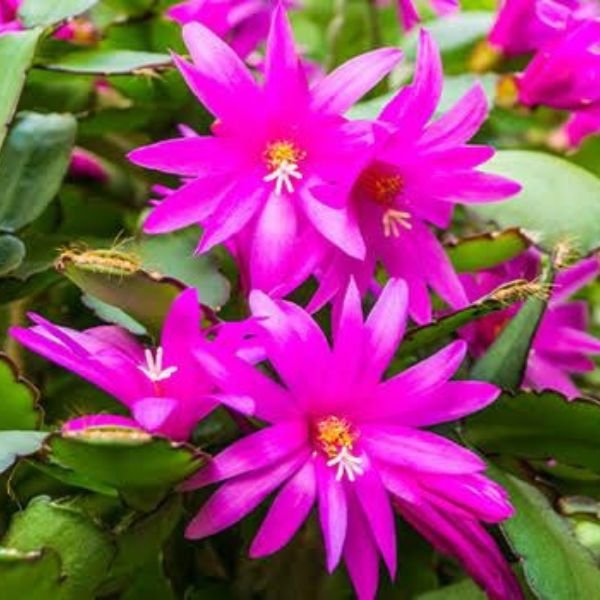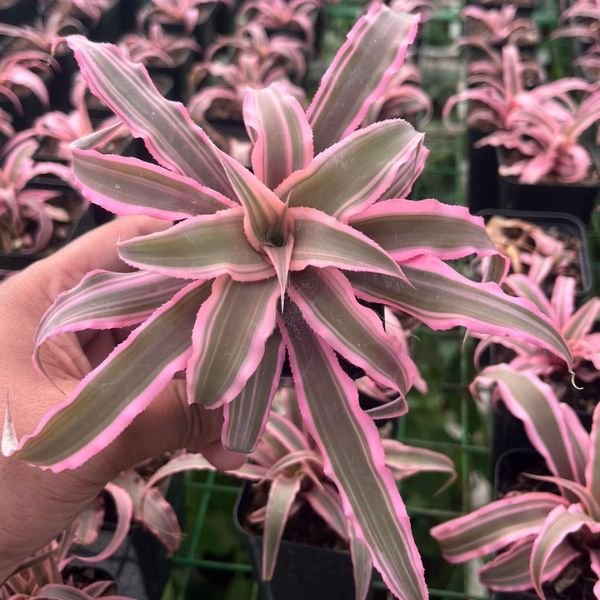In desert areas, a special kind of plant exists that is called the moon cactus. These indoor plants have a fascinating secret. They don\’t possess the power to produce their chlorophyll. To make up for this, they depend on a method called \”grafting\”. It\’s like they form a unique partnership with another plant to stay alive.
Moon cactus also known as Gymnocalycium Mihanovichii is native to South America. Looking like a ball on a green stand, moon cactus also known as Ruby Ball Cactus. It is unique for its chlorophyll-lacking mutants. Mutants are nothing but the Gymnocalycium mihanovichii. The bottom stem-like green part is a different species that contain chlorophyll.
Colorful mutant attached to the green host is the best part of this succulent. Globose mutants show yellow, red, and orange colors, depending on the species. This mutant has edged ribs and some thorns. This cactus gives you the pink attached coloring flowers in the springtime.
Anyone can plant this succulent as a potted or basket plant. Moon cactus is a short-lived succulent. The removal of two grafted botanical parts within some years inevitably leads to the demise of the moon cactus unless it undergoes regrafting onto a fresh rootstock.
Encountering the moon cactus means welcoming two plants united in a single pot. For succulents agriculturalist, the cactus is an easy option to cultivate and grow. You need to have the essential knowledge and discover everything to succeed in their care and growth from here.
Different colours of moon cactus
Orange moon cactus:The orange moon cactus isn\’t actually one cactus, but two! It\’s a vibrant orange Gymnocalycium grafted onto a green Hylocereus base. They make a striking pair, the bright top lacking chlorophyll and needing the green base for food. Though it can\’t bloom or survive on its own, the orange moon cactus is a fascinating and easy-to-care-for plant, needing just bright light and occasional watering. Its cheerful color adds a pop of fun to any windowsill!
Red Moon Cactus:Red moon cactus shines like a ruby, a bright blob on green spines. It lacks chlorophyll, can\’t eat sunlight alone, so hitches a ride on a green friend\’s back. Together they thrive, a vibrant duo under your watchful eye
Yellow Moon Cactus:Dazzling like sunshine, the yellow moon cactus is a sight to behold! This vibrant globe, grafted onto a green base, lacks chlorophyll, but steals the show with its radiant glow. Though it needs its partner for photosynthesis, it blooms with cheerful defiance, a beacon of sunny delight in the cactus world.
Temperature and Humidity
Moon cacti flourish in a favorable warm environment. Their preferred temperature range falls between 20°C to 35°C. This variety can tolerate high temperatures but not winter frost.
The indoor environment causes no harm to the moon cactus. Keep the moon cactus protected from cold drafts and cold temperatures less than 10°C.
The sudden temperature changes affect the blooming of the cactus. Less humidity is very beneficial for the health of the moon cactus. High humidity levels can be harmful to the moon cactus and increase its chances of getting attacked by pests and diseases. It\’s ideal for moon cactus when the less humid atmosphere mixes with the good air circulation.
Lighting
You need to give the proper lighting to the moon cactus. The upper part of the cactus can\’t tolerate plenty of sun whereas the lower part wants sunlight to thrive. The indoor setting will be more suitable than the outdoor setting for the moon cactus.
Direct sunlight can fade the attractive color of the mutant. Avoid direct sunlight as much as you can for outdoor planting of moon cactus. Good shading can save this cactus from outdoor sunburn.
Watering
Like the other succulents, the Moon cactus has low watering requirements. Before watering this cactus again, it\’s important to check the soil. If the soil is dry, you can water this plant again. The dormant period needs less amount of water than spring and summer.
Too much water for the Moon cactus is a big \’no\’ for the moon cactus as it can harm the plant. The rot root comes to surprise you if you let the soil wet or keep the moon cactus in water standing area. Good drainage is a crucial factor in growing this cactus.
High-temperature outdoor sights need to be watered regularly except for the small potted cactus, placed in the shade. Misting is not necessary in the winter season. However, you can only stick to misting instead of watering in the winter season.
Fertilization
Frequent fertilization is not necessary for the moon cactus. But if you want, fertilization benefits the cactus. The growing period of this cactus is the perfect time to apply the fertilizer. Suspend the fertilization in the dormant period.
Potting and Repotting
Succulent or cactus potting mix is the best medium to pot the moon cactus. Fast-drained soil with less pH is quite helpful for the planting of the moon cactus. A plastic container or clay pot with drainage holes is ideal for the moon cactus.
Moon cactus is not a fast-growing cactus so, you don\’t need to worry about repotting frequently. The repotting should be done in the summer every 2 to 3 years. Your cactus won\’t survive long if you don\’t regraft the cactus to a new host.
For repotting, slightly remove the cactus from the dry soil of the pot. Cut the dead or rotten roots before replacing them with the new medium and use the fungicide or pesticide on the affected areas. For successful reporting, spread the roots and water them after a week.
Pest and diseases
Mealybugs and spider mites can affect the cactus in a broad sense. As a remedy for these pests, you can use homemade pesticides or neem oil.
Rot root due to overwatering is the common disease of this cactus. In case of intense damage, remove the rock stock cactus and place the mutant on a new host. Reducing the watering for some days helps to prevent the root rot problem.
Color fading and presentation are other problems with the cactus. It is caused by too much powerful sunlight. Provide an outdoor shade or indoor area to solve this problem.
Propagation
If you ever noticed the extra small parts on the mutant then you can use it for propagation. Small mutants should be attached to a host or any part of the host.
Another option to propagate the cactus is to cut both the upper and lower sections of the moon cactus and fasten them until their union happens.
Extra Maintenance Care
Pruning the low portion after some months and in the repotting time gives additional care to the cactus. You can also repot the pruned part on a new pot. One thing is to remember that the upper colorful mutants can not live without the green host but only the green host can survive without the mutant.
For caring, make sure that you regraft your cactus before the separation of the mutant and the green stem-like host, or, your succulent will eventually die.
Moon cactus is suited for low-level humidity levels. So, having a humidity monitor and adjusting the humidity limit to a justified level according to the cactus requirements is essential.






